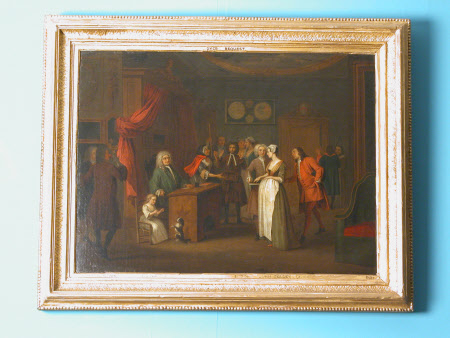The Affiliation (after Hogarth)
John Collett (London c.1725 - London 1780)
Category
Art / Oil paintings
Date
1750 - 1780
Materials
Oil on canvas
Measurements
44 x 610 mm
Order this imageCollection
Osterley Park and House, London
NT 771254
Summary
Oil painting on canvas, The Affiliation (after Hogarth) by John Collet (London c.1725 – London 1780). Scene in study or office. Figures standing engaged in conversation. Seated at desk man in blue coat, to his right girl seated, playing with black and white dog. The Affiliation is a copy after Hogarth's painting The Denunciation (or A Woman Swearing a Child to a Grave Citizen at the National Gallery of Ireland, (inventory number: NGI.618). In 1729 Hogarth exhibited and auctioned The Denunciation along with The Christening (private collection) at his Covent Garden studio. The subject matter and representation of these works suggests that they were conceived as a pair, with the Christening following the Denunciation in progress of events presented in these two works. The Denunciation presents a guilty and innocent party in this satirical look at contemporary life. The scene is set in the interior of magistrate's office. At the right of the group a heavily pregnant woman swears, with her right hand placed on the bible, before a magistrate that the centrally placed man is the father of her child. The accused is shown throwing his hands up in horror whilst his wife runs at him in anger. Standing just behind the young woman is her lover, the true culprit of her condition. He remains just outside the main group, elegantly inclining his head towards the young woman to instruct her on what she has to say. The magistrate is shown listening attentively, oblivious of the miscarriage of justice that is being conducted before him. This is parodied by the child sat to the side of the magistrate who is shown teaching a spaniel to sit up and beg. As with The Christening, the The Denunciation draws on the theatre for its composition. Here the figures, as Hogarth wrote, are presented 'As actors dressed for the sublime genteel comedy.' (See: Bindman, p.36). The setting also appears to be that of a stage for such a comedy. This is partly conveyed by a curtain being drawn back behind the magistrate and two fashionable society figureslooking on at the scene from the bottom left corner and emphasising our own roles as voyeurs of this event. The Christening, the The Denunciation is an example of Hogarth early scenes of everyday life, which he began to produce following the success of the Beggar's Opera. They can be seen as anticipating his later cycles of A Harlot's Progress (destroyed in 1755 but surviving in prints published in 1735) and The Rake's Progress (Sir John Soane's Museum) produced in the 1730s. [From V&A description]
Provenance
On loan from V&A (Dyce Bequest)
Marks and inscriptions
Title and author on frame - badly worn
Makers and roles
John Collett (London c.1725 - London 1780), artist after William Hogarth (London 1697 - London 1764), artist
